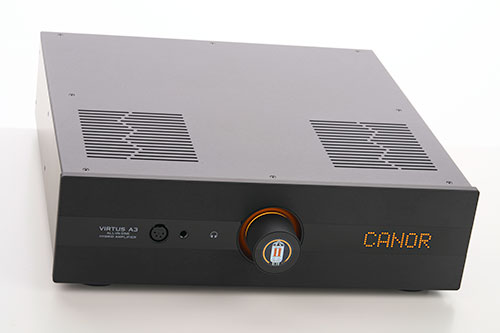The topic of master clock has been on my mind for some time now. It's fascinating to see what sonic improvements can still be teased with it out of a digital chain. The brand new REF10 NANO from MUTEC is a variant of the outstanding REF10 that concentrates on the essentials at half the price.
That's quite an announcement and makes the subject of clocking even more interesting as it already is. I've had two cascaded MUTEC MC3+ USB re-clockers in my inventory for many years and am always amazed at how good a digital chain can sound with them. And since my two tests of the REF10 and REF10 SE120 master clocks, I also know that it can be much better. However, I've always had a certain stomach rumble when a clock that's at least four times as expensive "only" clocks the MC3+ USB. To help you better understand what I mean, I need to expand a little. A master clock, such as the REF10 NANO, generates an extremely low phase noise 10 MHz clock signal. But we can't do anything with that at first. Modern DACs work with clock frequencies of 22.5792MHz or 24.5760 MHz, which are integer multiples of the standard audio sampling rates 44.1, 88.2, 176.4kHz and 48.0, 96.0, 192.0 kHz. With USB2.0 we have a clock frequency of 48 MHz and typical Ethernet clock frequencies are 25 MHz, 125 MHz and 156.25 MHz. Nowhere do we find 10 MHz.
Thus, we need a converter that synthesizes the required audio clock frequencies from the 10 MHz clock. The magic formula is called a "digital frequency synthesis". The task of such a process is to generate any clock frequency on the basis of a reference clock of 10 MHz. It is obvious that the clock provided on this basis depends not only on the precision of the clock itself, but also on the quality of this synthesis. A prerequisite for the use of a master clock is therefore that the device to be clocked has such a frequency synthesizer and a connection for an external 10 MHz clock. Unfortunately, there are currently not too many manufacturers and devices in the high-end sector that take this, admittedly complex, approach. MUTEC has compiled a list of currently available 10 MHz-compatible audio devices on its website. But there are still more hurdles to overcome: there is no consensus among manufacturers as to whether the reference clock is provided in the form of a sine wave signal or a square wave signal. Accordingly, it cannot be ruled out that the built-in frequency synthesizer will cope better or worse with one or other signal form. To make matters worse, there are also two standards for interface and cable termination: 50 ohms on the one side and 75 ohms on the other. In the high-end sector, we encounter both standards.

-
Canor Virtus A3
Zur diesjährigen HighEnd stellte Canor den Virtus A3 Hybrid-Vollverstärker vor. Der lockt mit einem integrierten Digital-Analog-Wandler und einer diskret aufgebauten Phono-Vorstufe für MM- und MC-Tonabnehmer. Sowohl seine Technik als auch die Ausstattung bieten Ungewöhnliches. Vor allem aber soll er klanglich beeindrucken. Das slowakische Entwickler-Team konnte mich bereits vor einem Jahr überzeugen: Der Vollverstärker Virtus I2 aus der Premium Line musizierte in meinem Hörraum wie keiner zuvor in dieser Preisklasse. Der war ein gestandener Röhren-Vollverstärker. Auch…28.11.2025 -
Dan D’Agostino Progression S350
Dan D’Agostino ist eine Legende im Verstärkerbau. Er folgte wohl nie einer Mode, sondern vertraut bei allen Entwicklungen seinem Gehör und seiner Leidenschaft für den guten Klang. Mehr als 50 Jahre baut er nun schon Verstärker, immer mit dem Ziel, das „Wesen der Musik hörbar zu machen“. Erfüllt auch der S350 diese hoch gesteckten Ambitionen? Die Progression S350 ist die kleinste Stereoendstufe im Gesamtprogramm. Optisch trägt sie alle charakteristischen Merkmale einer echten D’Agostino. Angefangen mit…25.11.2025 -
iFi Silent Power USB iPurifier Pro & Pulsar USB
Ohne iFis iDefender+ würde das PC-Audio-Setup in meinem Arbeitszimmer überhaupt nicht störungsfrei funktionieren. Dementsprechend ist es für mich eines der besten Tools im Bereich Computer-Audio. Der iPurifier Pro vereint seine Fähigkeiten mit denen eines iSilencer+ und noch mehr Features in einem Gehäuse. Außerdem teste ich das Pulsar USB-Kabel. iFi ist seit Jahren eine Konstante für hochqualitative Audio-Produkte zu fairen Preisen. Zuletzt wurde die Sparte für Stromversorgung, Kabel und Signal-Verbesserer unter SilentPower zusammengefasst. Noch bevor wir…21.11.2025 -
Eversolo T8
Der Eversolo T8 ist als Streaming-Transport ein neuer Baustein einer Konzeption, die auf Trennung der digitalen Komponenten setzt. Dennoch ist er nicht allein für Perfektionisten konzipiert, sondern bietet sogar Einsteigern vielfältige und sinnvolle Möglichkeiten. Die bislang allerorts hochgelobten Eversolo Streamer besitzen integrierte Digital/Analog-Wandler, sind teils auch als Vorverstärker nutzbar oder wie der Eversolo Play sogar als all-in-one Streamer, DAC und Vollverstärker. Mit dem T8 eröffnet Eversolo auf den ersten Blick eine neue anspruchsvolle Produktreihe, in…18.11.2025 -
Chord Huei
Auf kompromisslos Weise transferiert Chord Electronics sein digitales Know-how in die analoge Welt und präsentiert uns den kompakten Phono-Vorverstärker Huei. Das massive Aluminiumgehäuse beherbergt moderne SMD-Technik auf kleinstem Raum, womit die Briten den Beweis antreten wollen, dass Vinylgenuss kein großes Gehäuse braucht. Jetzt mal ehrlich, dieses ganze Hifi-Zeugs nimmt doch ohnehin schon genug Platz im Wohnzimmer ein und ich persönlich bin dankbar für jedes Gerät, dass ein wenig sparsamer mit dem auf dem Rack verfügbaren…11.11.2025 -
HMS Armonia Carbon
Sie haben vermutlich davon gehört, dass Hans Manfred Strassner, den man mit Fug und Recht als Vordenker hinsichtlich audiophiler Kabelentwicklung nicht nur in Deutschland anerkennen darf und sollte, sein Unternehmen HMS Elektronik aus Altersgründen zum 1.1.2024 an die International Audio Holding B.V., Inhaber der Marken Siltech und Crystal Cable, übergab. Dies ist inzwischen eine ganze Weile her, und nun ist der Zeitpunkt gekommen, an dem die Niederländer verbesserte Versionen des übernommenen Portfolios vorstellen. Dass seit…07.11.2025
© 2025 | HIFISTATEMENT | netmagazine | Alle Rechte vorbehalten | Impressum | Datenschutz

























 |
|
















































































